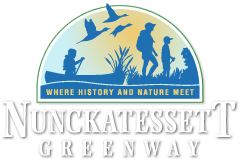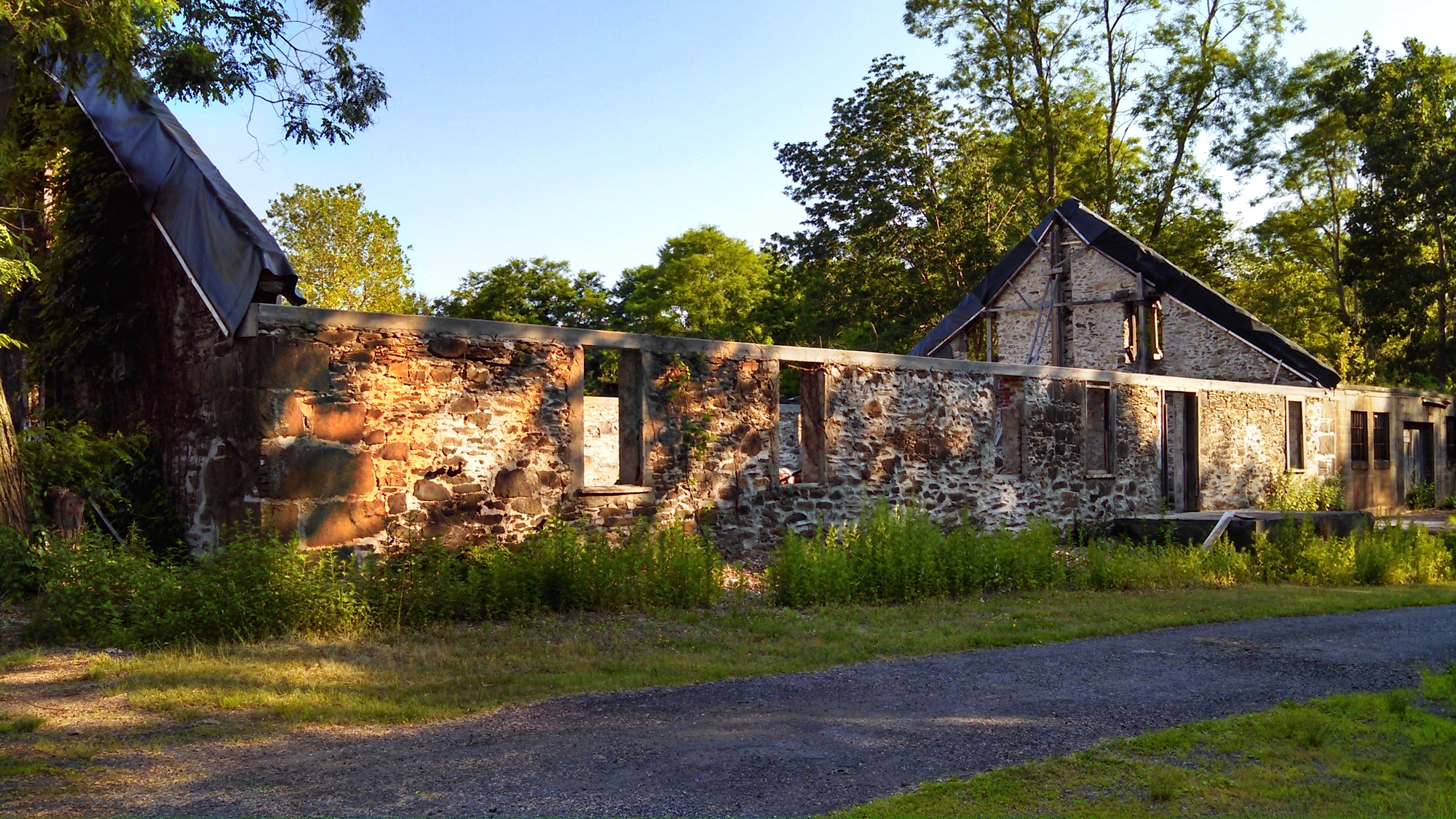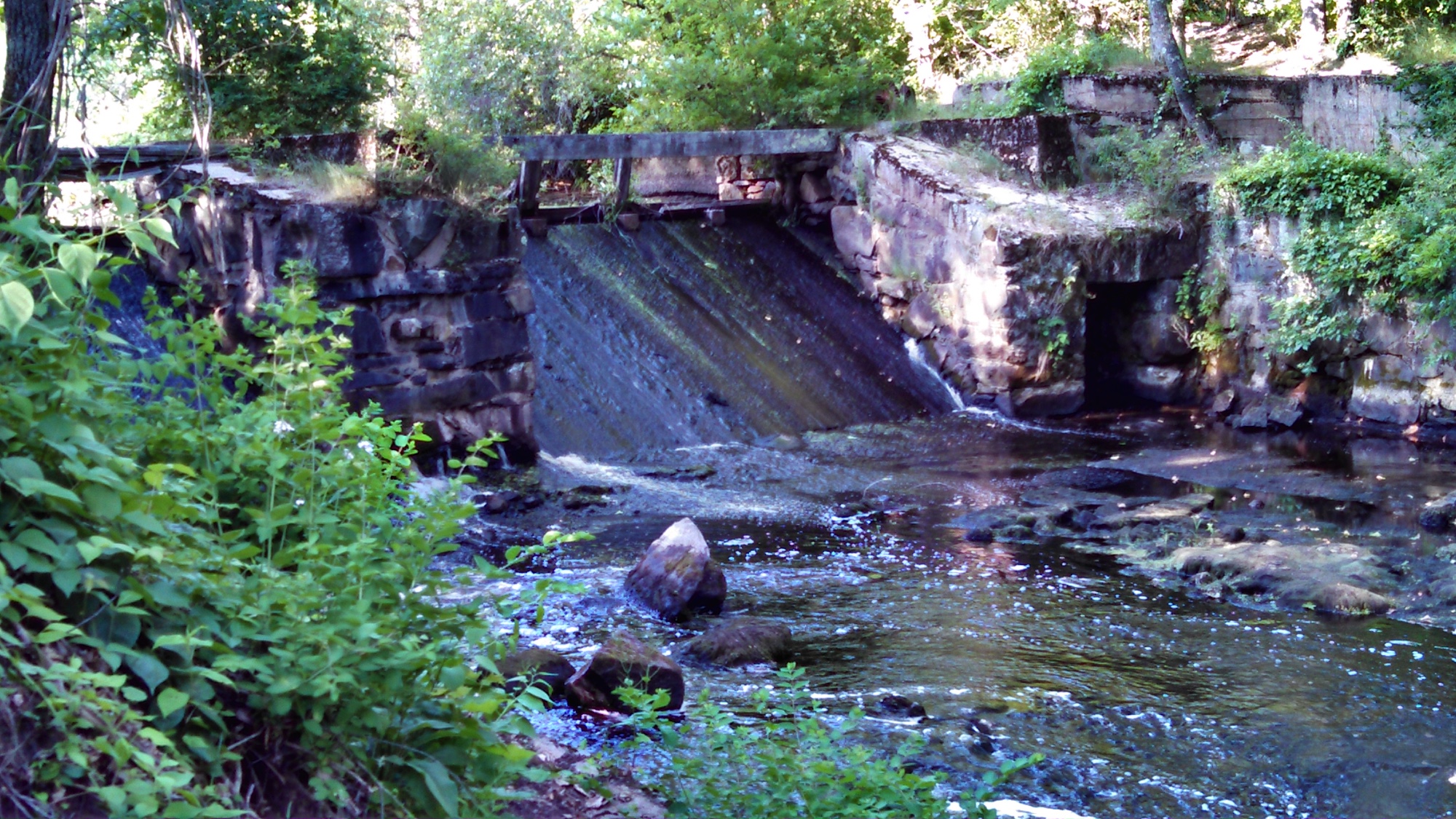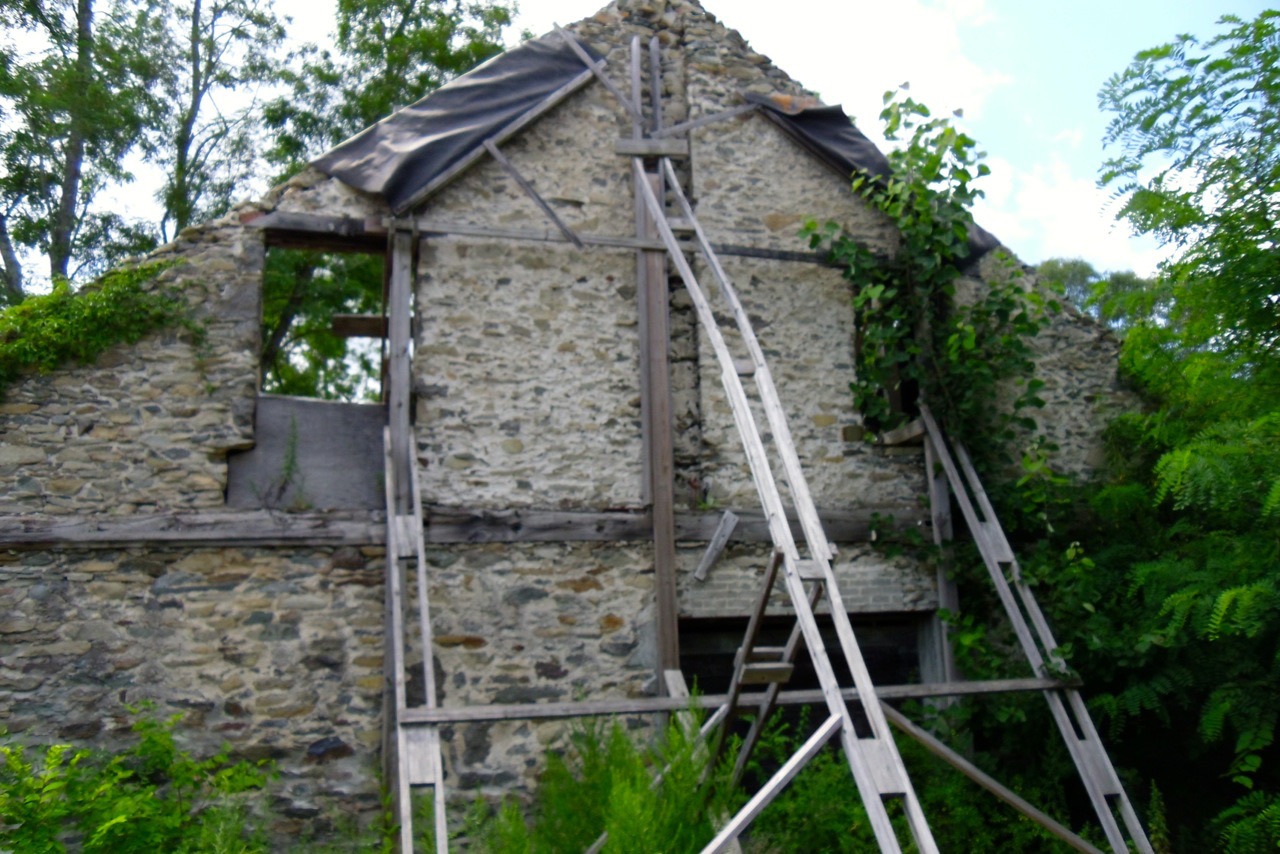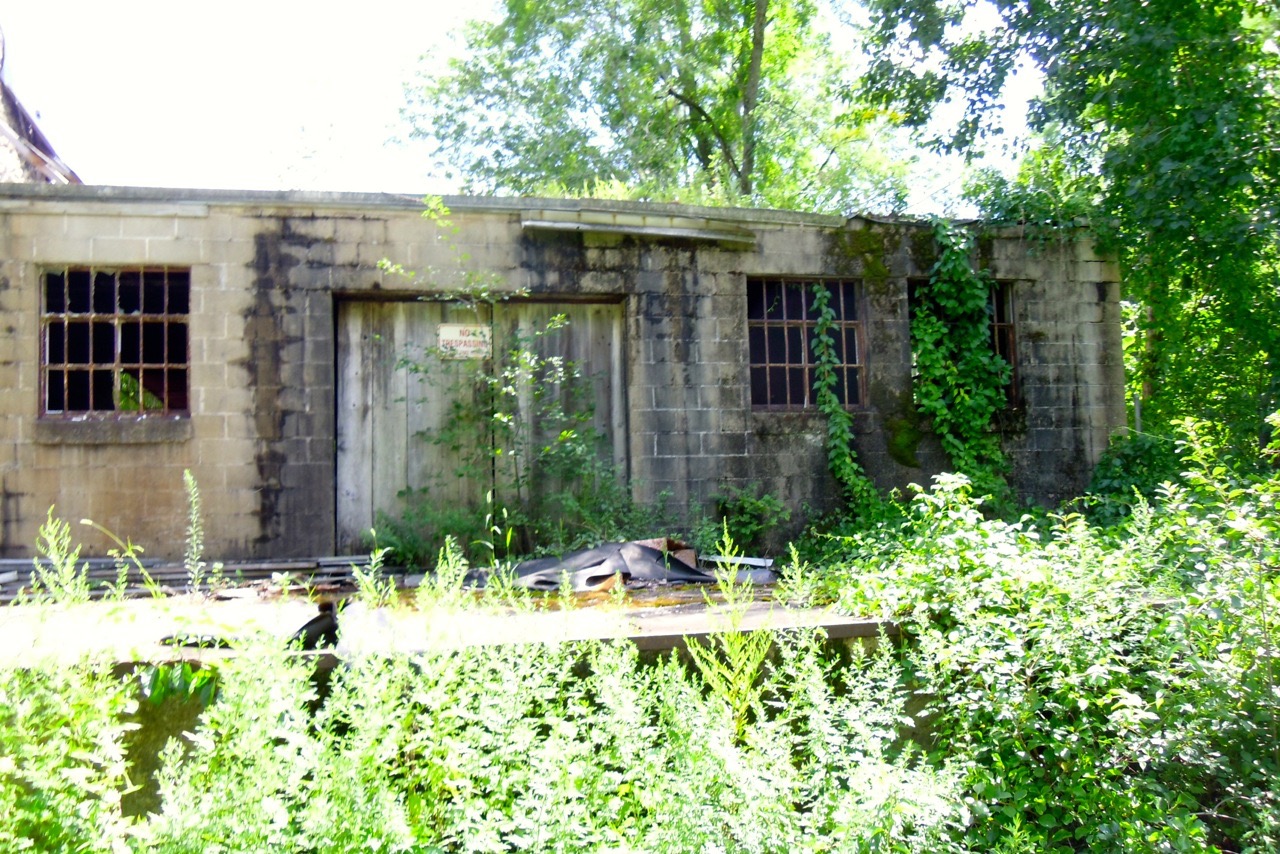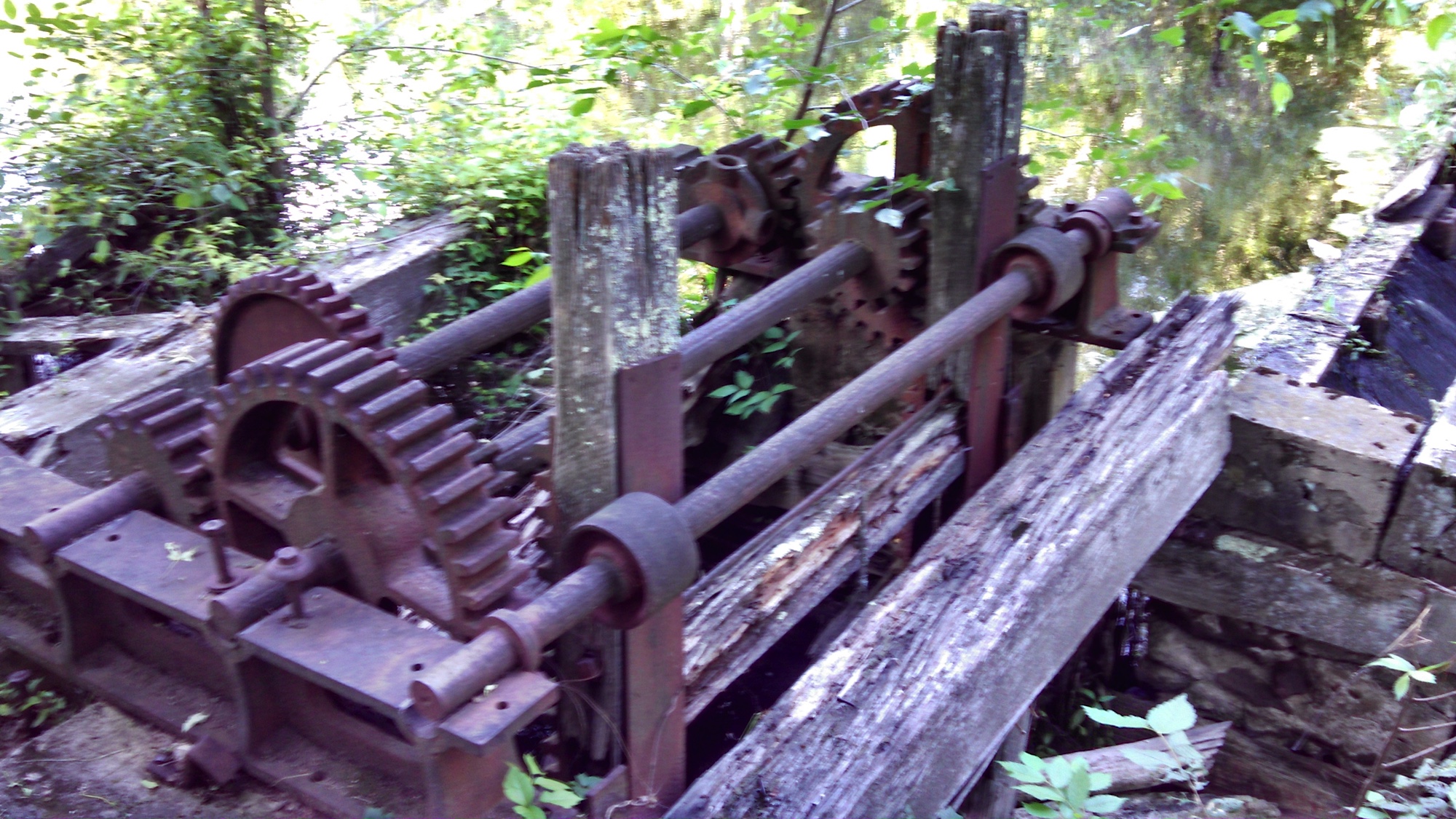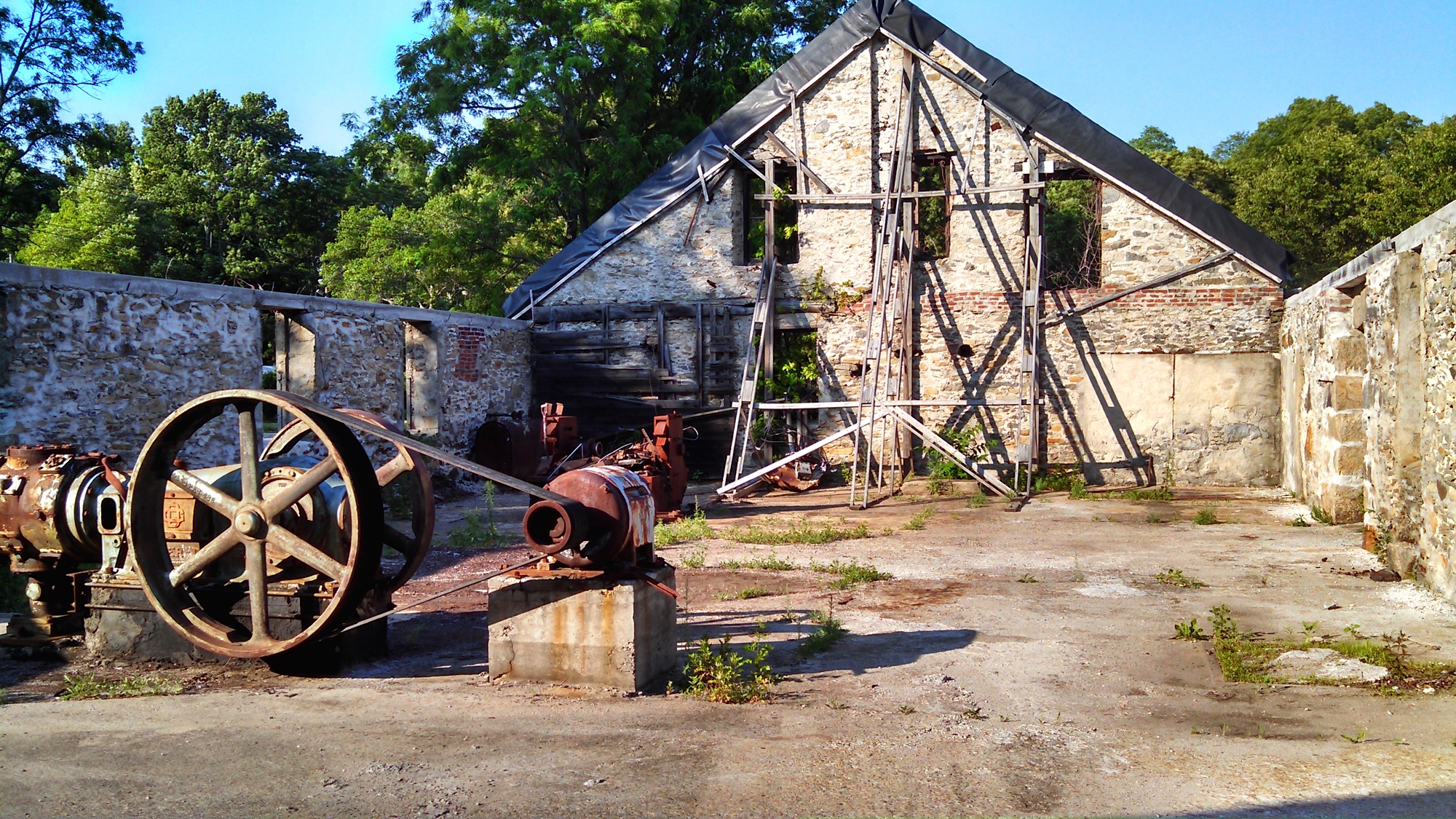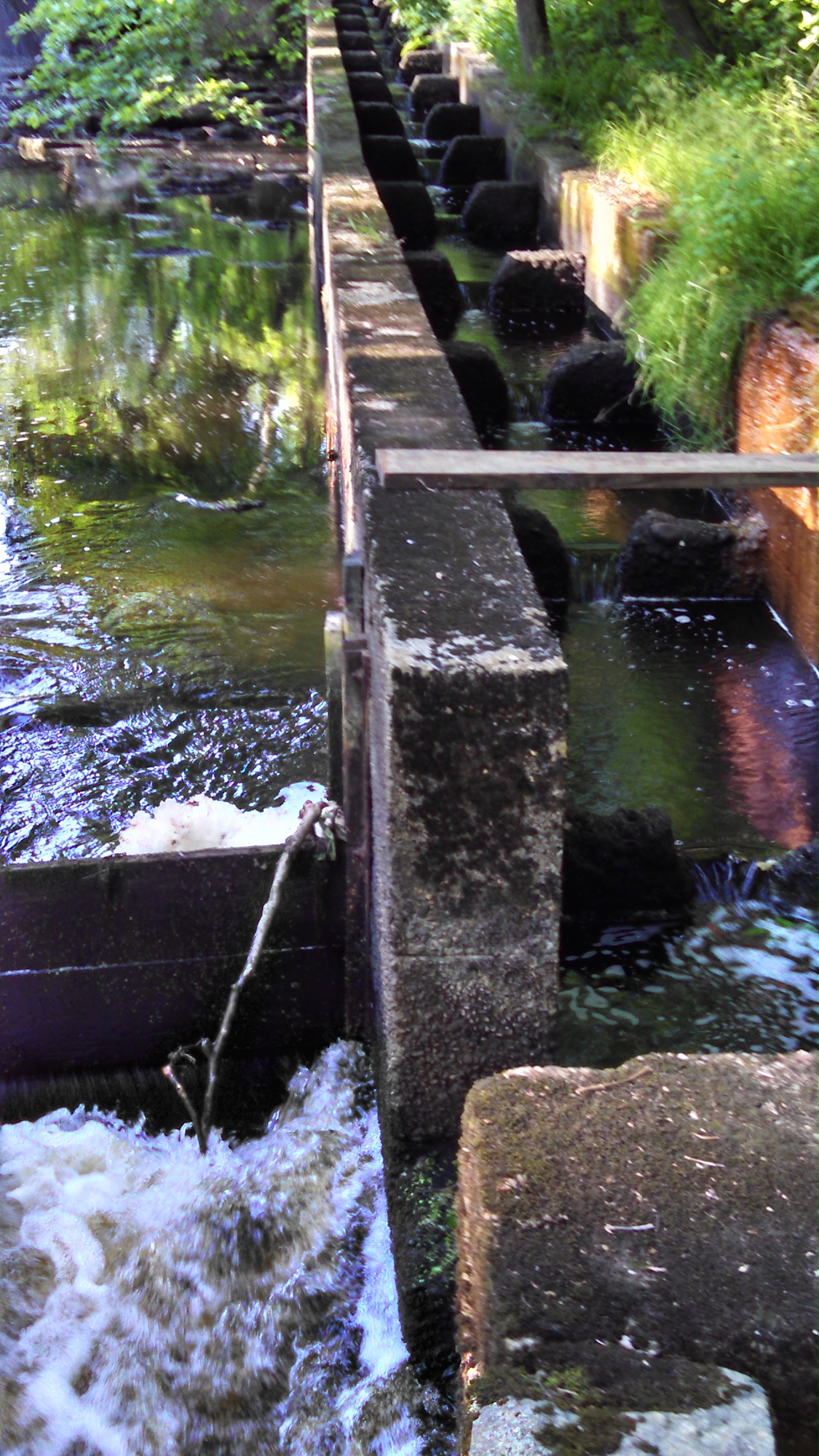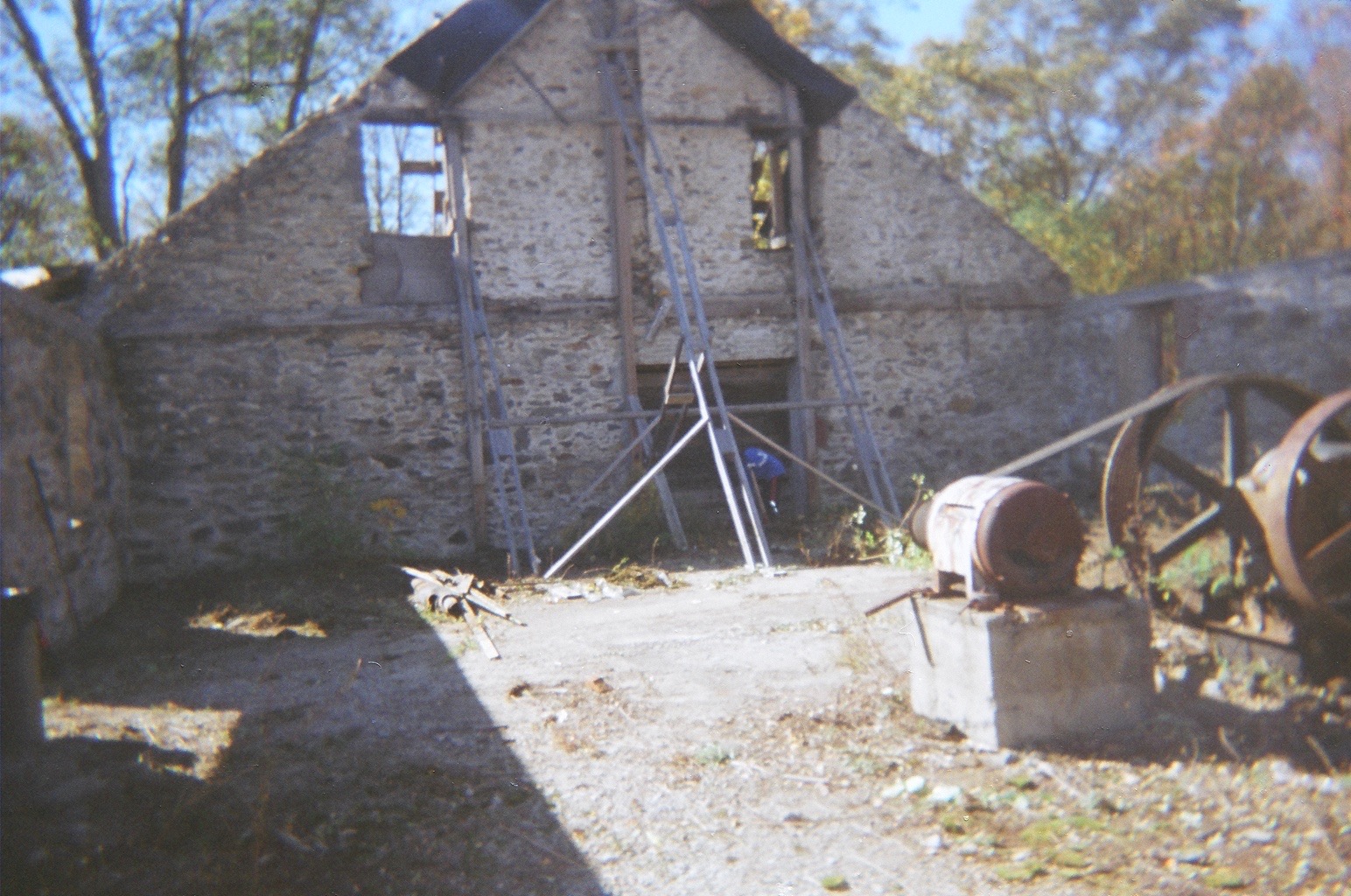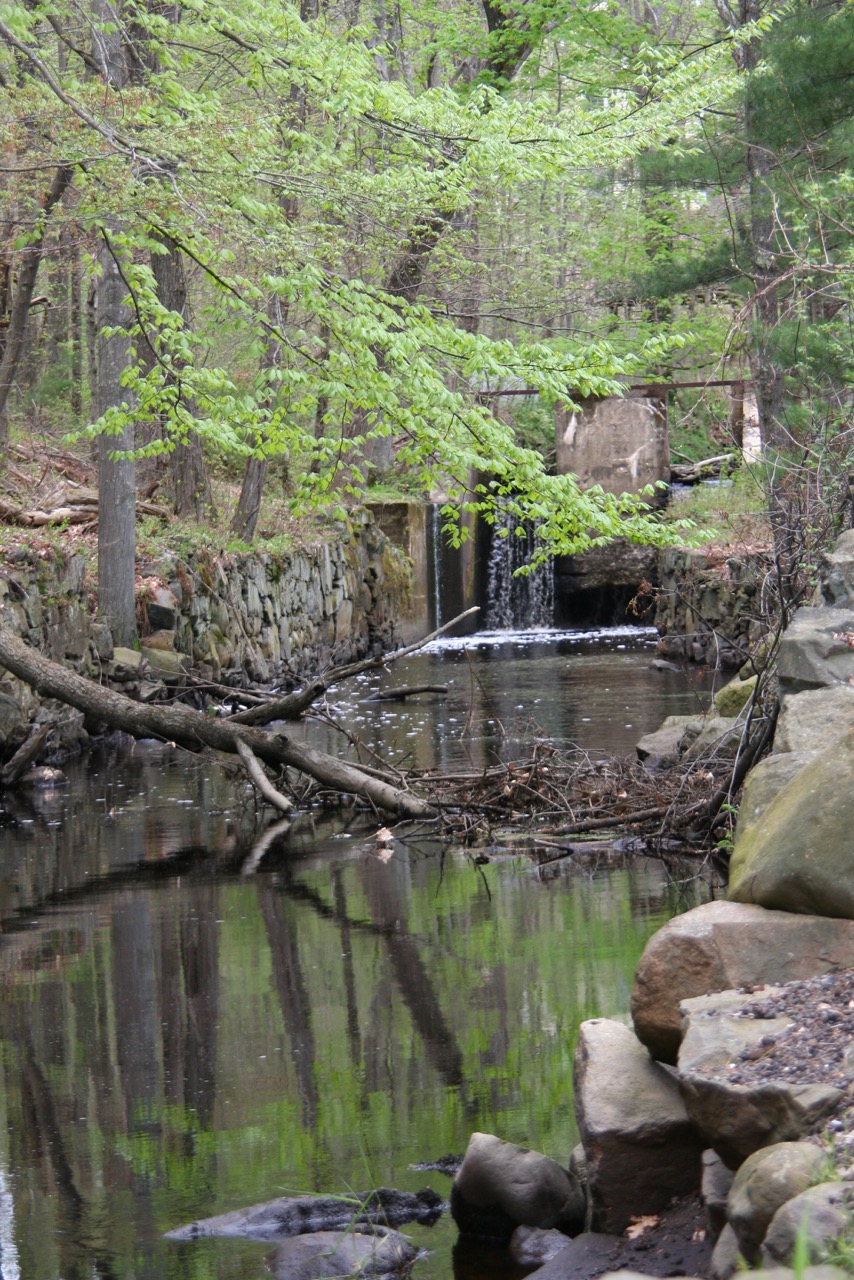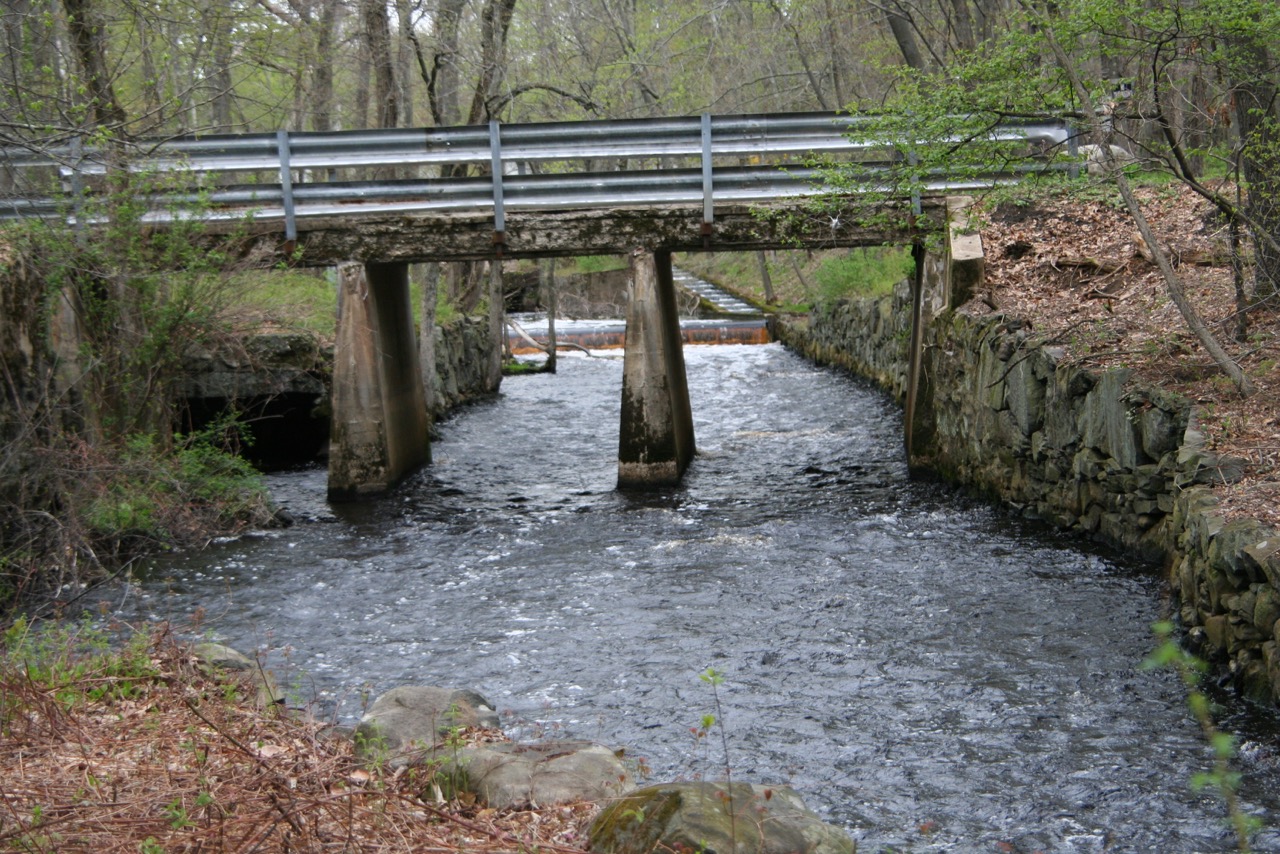Area: 12 acres.
Gift of: The Ladner and Brusseau Families, 1995.
Directions: Route 24 to Exit 16A. East on Route 106 (2.2 miles). Slight right onto Route 28 South (1.8 miles). Turn left onto High Street (0.3 miles). Turn right at Bridgewater Highway Department main entrance. Continue 500 feet, park access is to the right, off Highway Department maintenance yard.
Parking: There is currently a small undefined parking area (4 to 6 cars) located between the ruins of an old iron works building and a pond.
Established in 1691, the Bridgewater Iron Works at Stanley was the first to produce iron in the American colonies in by 1860 it had become the 2nd largest producer of iron in the U.S.
During the Civil War, it manufactured ammunition and iron signing for our ships. The ironworks industrial site was abandoned in 1988 in the land donated to the town of Bridgewater, MA. Today a new forest is establishing itself on and around the ruins of the old stone and slate foundry building.
Points of Interest
- A privately-owned dam with fish ladder to help our alewife herring migrate towards Lake Nippenicket.
- Walking trail on both sides of the Town River
- Within walking distance of the center of Bridgewater, MA
 A peaceful oasis with waterfalls and a babbling brook awaits your visit. Rich in history, with a prominent role in the industrialization of our country, Iron Works Park is within walking distance of Bridgewater Center. An alewife fish ladder to aid in the spawning of herring, a future canoe launch site, and walking trails to leisurely stroll the grounds all combine to make a unique open space experience.
A peaceful oasis with waterfalls and a babbling brook awaits your visit. Rich in history, with a prominent role in the industrialization of our country, Iron Works Park is within walking distance of Bridgewater Center. An alewife fish ladder to aid in the spawning of herring, a future canoe launch site, and walking trails to leisurely stroll the grounds all combine to make a unique open space experience.
Iron Works at Stanley, established in 1691, was not only the first to produce iron but by the Civil War, it was the largest producer of iron in the country. In 1988, the site was abandoned and the land donated to the town of Bridgewater. Iron Works became one of the six parklands in 1996.
The park is in the process of development with many exciting plans. Located in the Nunkatesset Greenway on the Bay Circuit Trail, a new entrance has been opened up on High St. The project was headed up by the Appalachian Mountain Club as part of the Bay Circuit Alliance with plans for more improvements. Also in the park are numerous foundations to be excavated and identified. Historic tours are available for groups. 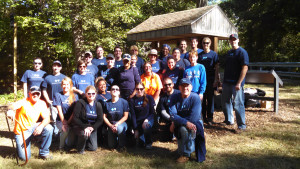 A fish ladder exists to observe the herring make their run, but access is difficult. Numerous scenic areas exist for picnicking. Fencing needs to be constructed to provide safety from the deep channels and rushing water. Canoes and kayaks can use an informal launch with a loop road planned for a more formal site.
A fish ladder exists to observe the herring make their run, but access is difficult. Numerous scenic areas exist for picnicking. Fencing needs to be constructed to provide safety from the deep channels and rushing water. Canoes and kayaks can use an informal launch with a loop road planned for a more formal site.
Your help in developing and maintaining the park would be greatly appreciated. Clean up days are planned for each Earth Day, April 22nd and possibly a day in the fall for all the parks. Iron Works Park is located on High Street, adjacent to the Highway Department and the 49ers Club.
 Town River at Iron Works Park
Town River at Iron Works Park
The Bridgewater Iron Works is a historic industrial site located on High Street in Bridgewater, Massachusetts along the banks of the Town River. Previously known as Lazell, Perkins and Company, by the mid-19th century, the Bridgewater Iron Manufacturing Company was one of the largest iron works in the United States, specializing in heavy castings and forgings. The property was later acquired by the Stanley Works, with the surrounding village still known to this day as Stanley.
The location was most recently used for manufacturing by the Bridgewater Foundry Company until 1988. It has since been converted into a small public park, with only the remnants of a stone storehouse remaining. The site was added to the National Register of Historic Places in 2002.
The industrial history of the site began in 1694, when David Perkins was granted permission to construct a dam across the Town River by the colonial government of Massachusetts. By 1707, Perkins had established a blacksmith shop at the site.
In 1785, brothers Isaac and Nathan Lazell built a new slitting mill on the site – the second mill in the country to erected after the end of the Revolutionary War. (The construction of new iron mills had been prohibited by the British Crown since 1750). A second slitting mill was added in 1793. By 1795, the Lazell brothers were manufacturing over 445 tons of iron per year. Jacob Perkins, a skilled mechanic soon joined the company, in which he later became a partner.
From 1810 to 1816, the company was known as Lazell, Carey & Company and produced cannons during the War of 1812 and iron pots for the whaling industry, among other items, including cut nails and iron hoops for wooden barrels. In 1816, Carey died and the company was renamed Lazell, Perkins & Company. In 1825, the company became incorporated as the Bridgewater Iron Manufacturing Company, but continued doing business as Lazell, Perkins & Company for many years after.
In 1830, the company began manufacturing steam engines and large additions were made to the works. However, this endeavor was discontinued after just a few years, with the firm deciding to concentrate on its iron and foundry businesses, including the machinery used in the production of these goods. In 1835, upon the death of Nathan Lazell, Jr., Nahum Stetson became treasurer. In the years to follow, Stetson, who had been with the firm since 1825, would guide the company through a period of great expansion, surviving the great financial Panics of 1837 and 1857. With his successes in Bridgewater, Stetson would also become associated with several other iron works in the area, including the Weymouth Iron Company in 1841, the Tremont Iron Works in Wareham in 1846, and the Providence Iron Company in 1854. Stetson was also later associated with the Old Colony Iron works in Taunton, as well as numerous other businesses in the region.
In 1845, the Fall River Railroad reached Bridgewater, and the following year, a connection to Boston was completed, allowing the company much easier access to these markets. The company grew rapidly during this time, and by the early 1850s, it employed 250 men and contained about 10 acres devoted to manufacturing. James Ferguson became superintendent of the works in 1856, and would be in charge of the daily operation of the company for several decades.
By 1860, at the dawn of the Civil War, the Bridgewater Iron Company was one of the largest in the country, specializing in heavy castings and forgings, including key parts for the United States Navy, including the famous USS Monitor and the USS New Ironsides iron-clad warships, and the Pacific Mail Steamship Company. By 1868, the company employed about 600 men. The company also produced drawn copper and brass tubes for steam boilers.
In 1899, the site was purchased by the Stanley Works of New Britain, Connecticut for the manufacture of machinery and steel plate used in tool production. The section of Bridgewater surrounding the plant soon became known as Stanley. The company operated the site until 1928, when production was shifted to New Britain. The site was then acquired by the George O. Jenkins Company, for storage of scrap paper.[2]
The property was heavily damaged by the Hurricane of 1938. Between 1946 and 1988, two buildings on the site were operated by the Bridgewater Foundry Company, which produced grey iron castings. The property was donated to the Town of Bridgewater in 1994 by the Brousseau and Landner families, the last owners of the foundry. Much of the site has been converted into Ironworks Park. The park includes a small bridge over the Town River, and the remnants of several buildings. Another portion of the property now contains the town’s highway department.
Stone Building Restoration Project
This brief is to present some background information on the Stanley Iron Works Park and the effort to save the only remaining building on the property, the stone storehouse building. It is the only building in town on the National Register of Historic Places, a proposed centerpiece for a headquarters for the town’s park system and as such is worth every effort to preserve it for future generations.
Our vision for the Stone Building is to serve as a Park Headquarters – Trailhead/Museum. The trails that will intersect here will be: a trail from East Bridgewater linking us to the Bay Circuit Trail that goes from Ipswich to Kingston, roughly along Route 495; a trail to Stiles and Hart Park, linking us to the center of town and the University and a trial to West Bridgewater’s War Memorial Park. Long term plans include bike paths and a kayak/canoe put in along the Town River. The building would be a natural headquarters for the Bridgewater Parks and a display center to house many of the towns historical artifacts. Part of the main building would house a small meeting room for town groups, including the Conservation Committee and the Parklands Stewardship Committee. Future plans call for bike/canoe/kayak rentals possibly run by the students at BSU, vending machines and a small patio – seating area.
- Phase 1 – Capping the gabled ends and preserving the walls. This is essential to having any kind of a project to go forward. From the Architect, structural engineer and mason would come the estimates for phase 2.
- Phase 2 – Installing the roof, walls and windows: we are currently working with the school department to obtain the roof from the Powleski farm property.
- Phase 3 – Installing a new appendage building that would house the bathroom and utilities and final landscaping.
The stone building off High Street near the Highway Barn in Bridgewater is the last remaining structure from the Stanley Ironworks. It is a state-recognized Historic District.
During the 1860’s, it was the second largest producer of iron in the country and was still operating until the 1990’s when the land became part of the Bridgewater parks system. It has been estimated that the walls of the building will be structurally defunct within 6 months without shoring up. The Town of Bridgewater, through its Community Preservation Committee has dedicated money to stabilize the walls to allow for future preservation and use of the site.
Andrew Howard, as part of an Eagle Project, has undertaken clean-up of the site. He took the “Before” photos to document the site’s condition before he and his troop began work. The “After” photos show the results of their enormous effort which allow greater access to the walls. Thanks to the troop and volunteers working intensively over two consecutive week-ends in the fall of 2013, the next phase of the restoration (wall stabilization) will be accomplished.
Development Plan
Goal: Making Iron Works Park an accessible and safe destination for hiking and picnicking, maintaining the Herring run, and preserving a part of Bridgewater’s historical past for viewing.
I. Projects Completed
- Kiosk – bench with information posted
- Clearing of woodland areas of invasive weeds and scrub brush
- Meadow – maintenance provided by highway department and Boot Camp
- Clearing and fencing of west channel dam
- Access to bridge and bridge improvements
- Trail along East channel
II. Short Term Projects
- Maintenance of trails: east channel, bridge to bottom of fish ladder, meadow to main dam, dam to front gate, meadow to west channel dam, meadow to south point of island and current canoe launch area. Mulch with wood chips.
- River and fish ladder viewing area – clearing, benches, fencing
- Connecting all trails and viewpoints through meadow with stone dust
- Pedestrian access from High Street – trailhead; signage; proper fencing; and build up berm with boulders
- Marker – provide history of park; identify ruins of old buildings-signage for each foundation; and self-guided tour
- Parking adjacent to Highway Department-sign on High Street
- Picnic Tables – take in-take out
- Clearing log jam behind dams and clearing vegetation off channel walls
III. Long Term
- Safety fencing on island protecting east and west channels: post and rail with mesh
- Existing storehouse – maintain until renovation: use as museum, visitor center, function hall for meetings, weddings
- Improved parking lot – adjacent to storehouse; handicap parking; and connecting trail from lot to bridge
- Canoe access – dirt road adjacent to highway department; connecting trail from road to river; signs on both sides of High Street for canoe portage
- Floating docks for better access to fish ladder
- Main dam – obtain access across private property (Mike Flaherty) or purchase land; major repairs to dam; provide trail access to dam-railings; and connect trail to bridge on east side of channel
- Clean up park
- Trails-connectors – to War Memorial Park and Bay Circuit Trail; and to Stiles and Hart Park
IV. Maintenance
- Schedule to be set by Parkland Stewardship Council
- Volunteer staff to be selected from: Town citizens; Friends of Stanley; Prison work teams; Ameri-Corp; Scouts; and Town Departments and Groups
- Highway Department
- Bridgewater Garden Club
- Bridgewater Improvement Association
- Parks and Recreation
For more information, please contact the Bridgewater Conservation Commission or you can email Stephen Black, Lead Steward, Ironworks at sjbbc50@comcast.net.
